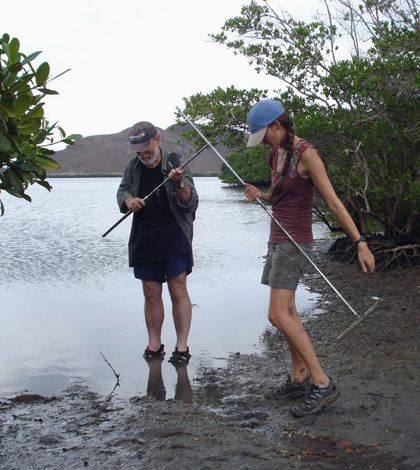Desert Mangroves Make Surprisingly Good Carbon Sinks

Exequiel Ezcurra (left), director of the University of California Institute for Mexico and the United States, and Paula Ezcurra, researcher with Scripps Institution of Oceanography, assemble a corer in a Baja, California mangrove area. (Credit: Exequiel Ezcurra)
The discovery that desert mangroves excel at storing carbon was, in many ways, a happy accident.
“It was my daughter’s doing,” says Exequiel Ezcurra, director of the University of California Institute for Mexico and the U.S. and adjunct professor at Scripps Institution of Oceanography. “Paula (his daughter) was an undergraduate and thought it would be interesting to look at the desert mangroves in terms of carbon storage when we were on a trip to Northwestern Mexico. I didn’t expect anything to come of it, and just went along with the idea for fun, but here it turned out to be this great, fascinating study. It just shows you that important science can come from anywhere. There was no reason to expect that desert mangroves would be great carbon sinks, but there was the evidence, staring us in the face.”
Desert mangroves were found to store up to five times more carbon underground than tropical mangroves. Although they occupy only 1 percent of the land in Baja California coastal desert terrain, they store about 30 percent of the area’s underground carbon.
Ezcurra and other researchers, including Matthew Costa, a graduate student at Scripps, learned about the desert mangroves’ superior carbon storage ability by taking deep underground cores.
On the surface around the mangroves, there may appear to be only mud, then from a half foot to a foot under that is clay. Underneath that, however, is peat, a material that essentially sucks up carbon from the atmosphere. “Peat stores lots of carbon…about 1 hectare stores 20,000 to 30,000 cubic meters of carbon,” says Ezcurra.
Although a number of researchers have investigated mangroves, such as Karen McKee of the U.S. Geological Survey, very little if any work had been done on mangroves’ ability to sequester carbon.
“In Belize, McKee found mangroves with especially impressive carbon sinks: The peat was 40 feet deep under them,” Ezcurra says.
The mud, clay and peat cores under the mangroves were drilled in two foot sections.
“The first foot of the mangrove core has bioturbation. In other words, animal life has been interacting with it. Fiddler or Uca crabs plow up the first foot of amorphous mud or ‘muck.’ Under that is the peat,” Ezcurra says. The corers are open-faced with a slot on one side. Core samples were also taken for analysis and stored in glass vials. Coring continued until the hard calcite layer was struck. “The calcite layer is 5,000 to 40,000 years old. You could drill in it to extract shells and analyze them, but we were not interested in that layer.”
The core samples were dried in an oven. An analysis of total carbon was performed with a spectrophotometer.
“We also have a Carbon Cycle Accelerator Mass Spectrometry Facility at UC Irvine, which we used to analyze 14C. Every sample was analyzed for age and total carbon content,” says Ezcurra. “But radiocarbon dating is expensive, so we only did one or two of those analyses per core.”
Five cores were taken in Bahía Magdalena in the Baja Peninsula. Six cores came from the Balandra area near La Paz, with another three gathered in Marismas Nacionales Marshland in Nayarit. Five more cores were collected at La Encrucijada, near the Mexican and Guatemalan border.
Optical microscopy was also performed on the peat portions of the cores, which has recognizable fragments and fibers, but was not performed on the amorphous mud portions above the peat, where there aren’t distinct pieces. The peat fragments are highly decomposed but still recognizable.
The red mangrove peat has roots in the surface, as well as insect remains and leaves that are still somewhat identifiable. Not all peat has the same composition: The Baja peat, for example, is formed underground from black mangrove roots and contains nothing other than roots.
“We also looked at tropical mangroves versus desert mangroves,” says Ezcurra. “The Chiapas tropical mangroves remove from the atmosphere 6 tons of carbon per hectare every year, compared to 2 tons of carbon per hectare in the desert. However, the Baja carbon was stored under mud flats. Even though the tropical mangroves take up more carbon, they don’t store it as effectively.”
He also noted that Arctic peat behaves sort of like desert mangrove peat: Both store carbon in a highly efficient way.
In terms of technologies that might be utilized in the future for more mangrove studies, Ezcurra says the techniques they currently have are cutting-edge, but he also nods to the foresight of some Mexican researchers of the past.
“Not many people know this,” he says, “but Mexico was a pioneer in aerial photography in the 1930s. People are now taking out those old images and comparing them to the modern ones to see how the landscape has changed. We hope to use them to understand conservation dynamics better. We’d also like to use more satellite image analysis.”
Lastly, Ezcurra wants to emphasize the carbon-sequestering power contained in the short, squat desert mangrove plant. “They can store 10-100 times per unit area compared to what the Amazonian rainforest stores,” he says. “We could use strategic planting of desert mangroves to reduce emissions and fight deforestation and degradation.”
Top image: Exequiel Ezcurra (left), director of the University of California Institute for Mexico and the United States, and Paula Ezcurra, researcher with Scripps Institution of Oceanography, assemble a corer in a Baja, California mangrove area. (Credit: Exequiel Ezcurra)




0 comments